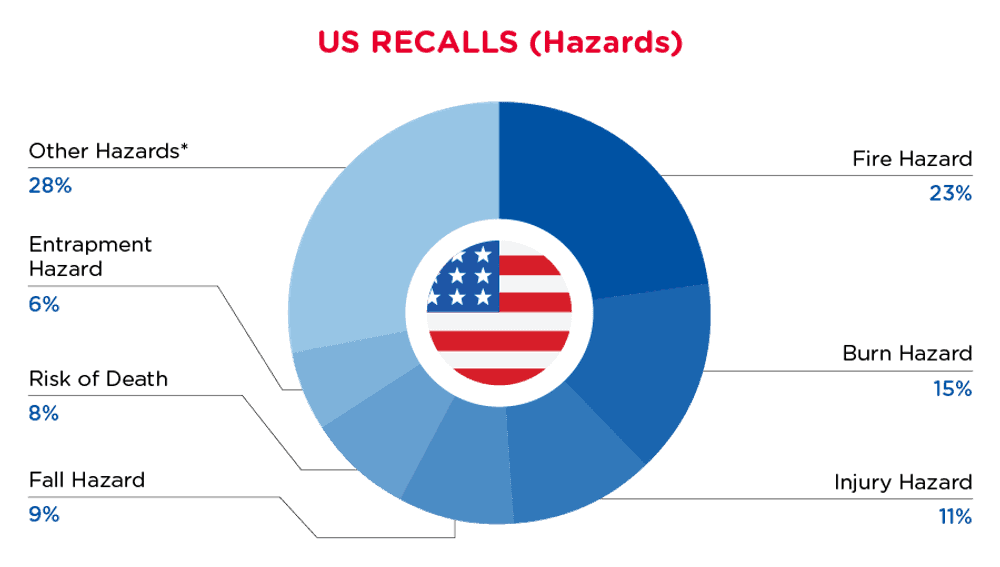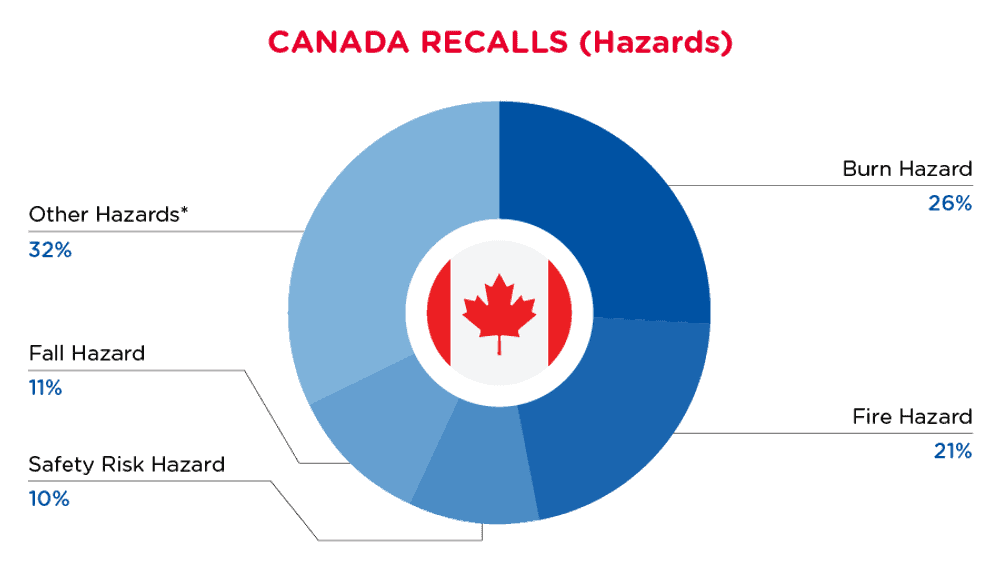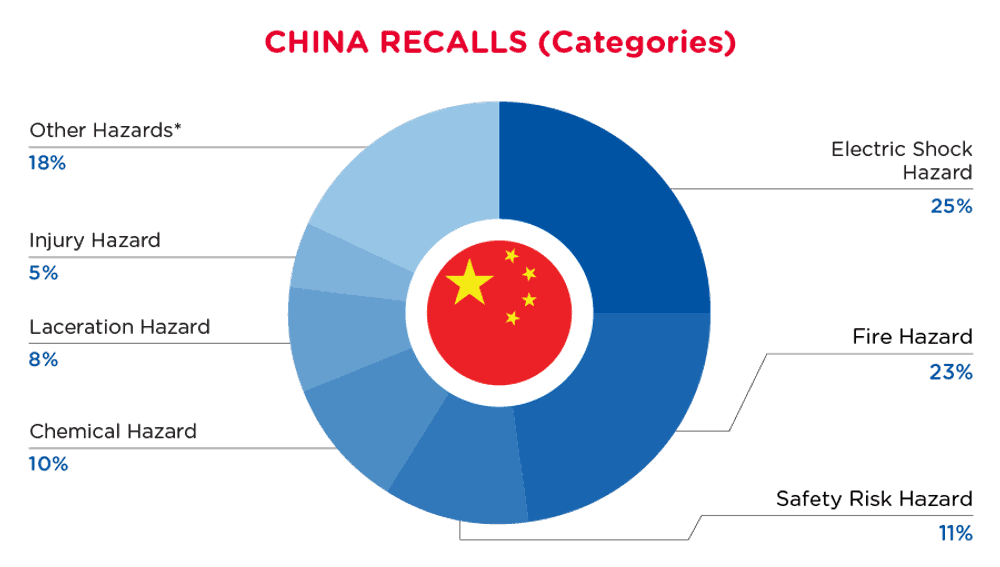July 2024
North America News
Im Juni 2012 veröffentlichte die U.S. Consumer Product Safety Commission (CPSC) gemäß Abschnitt 104 des Consumer Product Safety Improvement Act von 2008 (CPSIA) eine Verbrauchersicherheitsnorm für Babyschaukeln. Die durch Verweis aufgenommene Norm wurde aktualisiert und bezieht sich nun auf ASTM F2088-24, Standard Consumer Safety Specification for Infant and Cradle Swings. Die Vorschrift tritt am 14. September 2024 in Kraft, es sei denn, die Kommission erhält bis zum 1. Juli 2024 eine wesentliche negative Stellungnahme.
Die ASTM hat nun eine überarbeitete Norm herausgegeben, ASTM F2088-24, Standard Consumer Safety Specification for Infant and Cradle Swings. In Übereinstimmung mit dem CPSIA-Aktualisierungsprozess aktualisiert diese direkte endgültige Regelung die verbindliche Norm 16 CFR 1223, um die ASTM-Version 2024 der freiwilligen Norm durch Verweis aufzunehmen. Außerdem wird die verbindliche Norm dahingehend überarbeitet, dass sie "Wiegenschaukeln" einschließt, um sie mit der freiwilligen Norm in Einklang zu bringen.
Enthält wesentliche Änderungen der Anforderungen in Abschnitt 6.9, die sich mit der Strangulations- und Einklemmungsgefahr für nicht anwesende Personen im Zusammenhang mit angebundenen Gurten und Seilen an Schaukeln befassen
Behebt die Gefahr des Einklemmens und Strangulierens des Kopfes. Die überarbeiteten Anforderungen und die entsprechenden Prüfverfahren stellen sicher, dass alle Öffnungen, die durch den Gurt begrenzt werden, entweder zu klein sind, damit der Kopf eines Säuglings eindringen kann, oder groß genug, damit der Kopf des Säuglings entweichen kann.
Enthält überarbeitete Bestimmungen im Abschnitt Leistungsanforderungen (Abschnitt 6.9) und im Abschnitt Prüfmethoden (Abschnitt 7.16).
Hinzufügung der Verwendung eines Werkzeugs mit einer Klemmfläche von 3/4 Zoll Durchmesser während der Prüfmethode zur Bewertung des Gurtes/Seils, um die Konsistenz bei der Anwendung der Zugkraft zu gewährleisten.
Legt bei der Bewertung der begrenzten Öffnungen die Einsteckkräfte fest, die mit den kleinen und großen Kopfsonden verwendet werden müssen. Die Einsteckkräfte ermöglichen die Komprimierung weicher Güter im Prüfbereich und die Konsistenz der Prüfung.
Aufnahme einer Bestimmung in die Prüfmethoden, wonach eine zylindrische Sonde mit einem Umfang von 7,4 Zoll zur Bewertung der Länge und Straffheit des Gurtes/Seils nach der Prüfung mit der großen Kopfsonde bei der Bewertung der begrenzten Öffnung verwendet werden kann
Enthält neue Abbildungen mit Abmessungen und Illustrationen zu einigen Sonden
Enthält mehrere kleinere Ergänzungen und Überarbeitungen, die redaktioneller Natur sind und keine inhaltlichen Anforderungen der Norm ändern.
Die Vorschrift tritt am 14. September 2024 in Kraft, es sei denn, die Kommission erhält bis zum 1. Juli 2024 eine wesentliche negative Stellungnahme.
New Regulations have been enacted specific to the prohibition of mercury-containing lighting products in the state of Minnesota.
To protect the environment and public health, Minnesota has enacted a new law prohibiting the sale and distribution of mercury-containing general-purpose lighting products. The regulations are as follows:
Effective Dates:
Starting 1 January 2025: The sale, offering for sale, or distribution of newly manufactured screw- or bayonet-base compact fluorescent lamps (CFLs), mercury vapor lamps, and mercury vapor lamp ballasts is prohibited.
Starting 1 January 2026: The sale, offering for sale, or distribution of newly manufactured pin-base compact fluorescent lamps or linear fluorescent lamps is prohibited.
Exemptions:
The following lighting products are exempt from this prohibition:
Lamps designed and marketed exclusively for image capture and projection (e.g., photocopying, printing, film projection).
Lamps emitting a high proportion of ultraviolet light used for germicidal purposes, disinfection, fly-trapping, ozone generation, coral zooxanthellae symbiosis, or sunlamp products.
Specialty application mercury vapor lamp ballasts.
Compact fluorescent lamps used to replace lamps in motor vehicles manufactured on or before January 1 2020.
Additional Provisions:
Nothing in this section limits the ability of a utility to offer energy-efficient lighting, rebates, or lamp-recycling services or to claim energy savings resulting from such programs through the utility's energy conservation and optimization plans approved by the commissioner of commerce under section 216B.241 or an energy conservation and optimization plan filed by a consumer-owned utility under section 216B.2403.
Reference Link:
Health Canada has made changes to the Cosmetic Ingredient Hotlist in May 2024.
In May 2024, Health Canada updated the Cosmetic Ingredient Hotlist. The Cosmetic Ingredient Hotlist is an administrative tool used by Health Canada to communicate to manufacturers and others that certain substances may be prohibited or restricted for use in cosmetics.
The changes include the below:
Items added: Basic green 4, Benzophenone, p-Chloro-m-cresol & Solvent violet 13
Items Amended:
Dialkanolamines, secondary - entry amended to include secondary alkyl- and alkanolamines and their salts for clarity.
Alpha-hydroxy acids - entry amended to clarify that Polyhydroxy acids (PHAs) and bionic acids with alpha-hydroxyl groups are included, and the maximum permitted concentration for consumer use category was increased from 10% to 18%.
Hydroquinone - entry amended to expand the permitted nail product categories and increase the maximum concentration permitted.
p-Hydroxyanisole - entry amended to introduce a combined limit when both p-hydroxyanisole and hydroquinone are used in a nail product.
Talc - entry amended to help reduce chronic inhalation and genital exposure.
Manufacturers and importers should take note of these updates.
In the US, when hazards are identified in consumer products, they will be recalled and published in the Consumer Product Safety Commission (CPSC) Recent Recalls on the CPSC website, which is updated daily. The US recalls from 01 June 2024 to 30 June 2024 are summarized below:

| Hazards | Frequency |
| Fire Hazard | 12 |
| Burn Hazard | 8 |
| Injury Hazard | 6 |
| Fall Hazard | 5 |
| Risk of Death | 4 |
| Entrapment Hazard | 3 |
| Other Hazards* | 15 |
*Other Hazards include Laceration Hazard, Tip-Over Hazard, Crushing Hazard, Crash Hazard, Swallowing Risk, Safety Risk Hazard, Microbiological Hazard, Skin Irritation Risk Suffocation Hazard, Chemical Hazard, Electric Shock Hazard, Amputation Hazard and Eye Irritation Risk with a frequency of less than 3.

| Product Categories | Frequency |
| Electrical Appliances | 8 |
| Toys and Childcare Products | 5 |
| Sporting Goods / Equipment | 5 |
| Furniture | 3 |
| Household Items | 2 |
| Home Electrical Appliances | 2 |
| Other Categories* | 5 |
*Other Categories include Tools and Hardware, Pet Items, Machinery, Fabric / Textile / Garment / Home Textile and Food Contact Material with a frequency of less than 2.
For a complete list click here
In Canada, when hazards are identified in consumer products, they will be recalled and published in the Recalls and Safety Alerts Database on the Health Canada website, which is updated daily. The Canada recalls from 01 June 2024 to 30 June 2024 are summarized below:

| Hazards | Frequency |
| Burn Hazard | 5 |
| Fire Hazard | 4 |
| Safety Risk Hazard | 2 |
| Fall Hazard | 2 |
| Other Hazards* | 6 |
*Other Hazards include Microbiological Hazard, Skin Irritation Risk, Laceration Hazard, Suffocation Hazard, Eye Irritation Risk and Entrapment Hazard with a frequency of less than 2.

| Product Categories | Frequency |
| Electrical Appliances | 4 |
| Toys and Childcare Products | 2 |
| Sporting Goods / Equipment | 2 |
| Tools and Hardware | 1 |
| Fabric / Textile / Garment / Home Textile | 1 |
| Pet Items | 1 |
| Machinery | 1 |
| Home Electrical Appliances | 1 |
For a complete list click here
Europe News
On 01 July 2024, the European Commission issued the first update to the Rolling List of (groups of) Substances for Restriction, which is appended to the European Restrictions Roadmap published in April 2022. This update provides information on substances that are being considered for potential restriction under the REACH regulation.
The updated Rolling List of substances for restriction was updated on 01 July 2024.
This roadmap describes ongoing efforts and coming plans for restrictions under the European Union (EU) Registration, Evaluation, Authorisation and Restriction of Chemicals (REACH) regulation.
The Rolling List is divided into two pools as below.
Pool 0 Substances already included in the Registry of Intention (RoI) for restrictions or where the Commission has requested the European Chemicals Agency (ECHA) to prepare a restriction dossier.
Pool 1 Substances for which work is advanced and are under consideration by ECHA, Member States, or the Commission for restriction. For “Pool 0”, the recent updates are summarized as below.
| Subject | Hazards | Uses | State of Play |
| Carcinogenic, Mutagenic, and Reprotoxic (CMRs) in childcare articles | CMR | Articles | ECHA investigation report submitted; REACH committee discussion planned for October 2024 |
| Chromium VI compounds | CMR | Industrial, Professional | RoI entry added October 2023; Annex XV dossier submission planned for 4 April 2024 |
| 1,4-dioxane | Carcinogenic, Persistent, mobile and toxic (PMT-like) | Industrial, Professional, Consumer | RoI entry updated October 2023; Annex XV submission planned for October 2025 |
| Octocrilene | Aquatic toxicity | Specific uses in plastisol and cosmetics | RoI entry added October 2023; Annex XV dossier submission planned for 10 January 2025 |
And highlights for “Pool 1” are shown as below:
Polyvinyl Chloride (PVC) and its additives: Possible mandate to ECHA for restriction dossier preparation, anticipated RoI inclusion in Q3 2024.
Flame retardants: Investigation report due December 2024; potential restriction dossier decision in Q4 2024/Q1 2025.
Ortho-phthalates (C4-C6): Possible restriction via Article 69(1), not anticipated before Q4 2025.
Bisphenols: Assessment ongoing for further regulatory action, including restrictions, Substances of Very High Concern (SVHC) identification, or Harmonised, Classification, Labelling (CLH).
Hydrocarbyl siloxanes: Potential restriction based on Bio-accumulative and Toxic (PBT) or very Persistent and very Bio-accumulative (vPvB) properties, not anticipated before 2025.
The update also includes information on restriction cases under opinion making, decision making, or recently decided.
This update reflects the EU's ongoing efforts to manage chemical risks and implement the Chemicals Strategy for Sustainability. Stakeholders should monitor these developments closely as they may impact various industries and product categories.
In Europe, when hazards are identified in non-food consumer products, the products will be recalled and published in the Safety Gate system, which is updated weekly. The European recalls from 01 June 2024 to 30 June 2024 are summarized below:

| Hazards | Frequency |
| Chemical Hazard | 124 |
| Injury Hazard | 31 |
| Choking Hazard | 22 |
| Environmental Hazard | 17 |
| Burn Hazard | 15 |
| Fire Hazard | 12 |
| Electric Shock Hazard | 12 |
| Other Hazards* | 22 |
*Other Hazards include Damage to Hearing, Strangulation Hazard, Suffocation Hazard, Drowning Hazard, Health Risk Hazard and Cut Hazard with a frequency of less than 12.

| Product Categories | Frequency |
| Bodycare / Cosmetics | 80 |
| Toys and Childcare Products | 36 |
| Electrical Appliances | 28 |
| Jewelry | 19 |
| Outdoor Living Items | 12 |
| Fabric / Textile / Garment / Home Textile | 10 |
| Chemicals | 6 |
| Other Categories* | 20 |
*Other Categories include Sporting Goods / Equipment, Computer / Audio / Video / Other Electronics & Accessories, Accessories, Stationery, Machinery, Food Contact Material, Footwear, Protective Equipment and Home Electrical Appliances with a frequency of less than 6.

| Notifying Country | Frequency |
| Italy | 63 |
| Sweden | 27 |
| Germany | 19 |
| France | 16 |
| The Netherlands | 14 |
| Czechia | 11 |
| Hungary | 11 |
| Lithuania | 8 |
| Ireland | 8 |
| Other Countries* | 34 |
*Other Countries include Slovakia, Denmark, Poland, Finland, Romania, Bulgaria, Spain, Malta, Belgium and Austria with a frequency of less than 8.
For a complete list click here
Asia News
Am 10. Juli 2024 wurde im japanischen Amtsblatt die Kabinettsverordnung Nr. 244 zur Aufnahme von PFOA-Isomeren oder deren Salzen und PFOA-verwandten Verbindungen als spezifizierte chemische Stoffe der Klasse I veröffentlicht, die eine Änderung der Kabinettsverordnung Nr. 202 von 1974 darstellt. Mit Ausnahme des Übergangszeitraums für 8:2 FTOH und PFOI wird diese Änderung am 10. Januar 2025 in Kraft treten.
Japan hat mit der Kabinettsverordnung Nr. 244, die die Kabinettsverordnung Nr. 202 aus dem Jahr 1974 abändert, seinen Geltungsbereich für das Chemikalienmanagement bei spezifizierten chemischen Stoffen der Klasse I erweitert. Damit werden die Bemühungen fortgesetzt, sich mit Chemikalien zu befassen, die sich als krebserregend für den Menschen erwiesen haben. Die wichtigsten Inhalte der Kabinettsverordnung Nr. 244 sind:
Erweiterung des Geltungsbereichs von PFOA-verwandten Stoffen; siehe die Vergleichstabelle der PFAS, die in den spezifizierten Stoffen der Klasse I aufgeführt sind(Tabelle 1 unten, mit aktualisiertem Inhalt in rot):
Tabelle 1
| Vorherige | Aktualisiert | ||
| Eintrag 17 | PFOS oder seine Salze | Eintrag 17 | PFOS oder seine Salze |
| Eintrag 18 | PFOSF | Eintrag 18 | PFOSF |
| Eintrag 34 | PFOA oder seine Salze | Eintrag 34 | PFOA oder seine Isomere oder deren Salze |
| Eintrag 35 | PFHxS oder seine Isomere (beschränkt auf verzweigte Strukturen mit 6 Kohlenstoffatomen) oder ihre Salze | Eintrag 35 | PFOA-verwandte Verbindungen (Perfluoroctyljodid (PFOI), 8:2-Fluortelomeralalkohol (8:2 FTOH) und Stoffe, die zu PFOA abgebaut werden) |
| / | / | Eintrag 36 | PFHxS oder seine Isomere (beschränkt auf verzweigte Strukturen mit 6 Kohlenstoffatomen) oder deren Salze |
2. Verbot für importierte Produkte, die PFOA-verwandte Verbindungen enthalten (siehe Tabelle 2 unten)
Tabelle 2
| Substanz | Produkt/Umfang | Anforderung | Wirksam Datum |
| PFOA-verwandte Verbindungen (außer 8:2 FTOH und PFOI) | Antischaummittel Mit öl- oder wasserabweisenden Eigenschaften behandelte Kleidung Mit öl- oder wasserabweisenden Eigenschaften behandelte Textilien Feuerlöscher, Feuerlöschmittel für Feuerlöscher und Feuerlöschschäume Bodenbeläge, die mit öl- oder wasserabweisenden Eigenschaften behandelt sind Bohnerwachs Ölabweisende, wasserabweisende und fäulnishemmende Mittel sowie Faserschutzmittel Optische Fasern oder auf optische Fasern aufgebrachte Beschichtungsmittel | Verbotene | 10 Jan 2025 |
| 8:2 FTOH | Invasive und implantierbare medizinische Geräte | Verbotene | 3. Dezember 2025 |
| PFOI | Herstellung von Perfluorooctylbromid (PFOB) für pharmazeutische Produkte | Verbotene | 31. Dezember 2036 |
China News
In China, when hazards are identified in consumer products, they will be recalled and published in the SAMR Defective Product Administrative Centre, which is updated daily. The China recalls from 01 June 2024 to 30 June 2024are summarized below:

| Hazards | Frequency |
| Electric Shock Hazard | 46 |
| Fire Hazard | 42 |
| Safety Risk Hazard | 20 |
| Chemical Hazard | 18 |
| Laceration Hazard | 14 |
| Injury Hazard | 10 |
| Other Hazards* | 34 |
*Other Hazards include Burn Hazard, Suffocation Hazard, Explosion Hazard, Crash Hazard, Entanglement Hazard, Microbiological Hazard, Choking Hazard and Puncture Hazard with a frequency of less than 10.

| Product Categories | Frequency |
| Home Electrical Appliances | 22 |
| Electrical Appliances | 12 |
| Sporting Goods / Equipment | 10 |
| Fabric / Textile / Garment / Home Textile | 6 |
| Food Contact Material | 4 |
| Stationery | 4 |
| Other Categories* | 11 |
*Other Categories include Household Items, Chemicals, Protective Equipment, Toys and Childcare Products, Footwear and Furniture with a frequency of less than 4.

| Provinces | Frequency |
| Anhui | 14 |
| Guangdong | 13 |
| Hunan | 10 |
| Fujian | 6 |
| Hebei | 5 |
| Zhejiang | 5 |
| Other Provinces* | 16 |
*Other Provinces include Shanghai, Beijing, Hubei, Sichuan, Henan, Guangxi, Inner Mongolia, Yunnan and Jilin with a frequency of less than 5.
For a complete list click here
Australia/New Zealand News
In Australia, when hazards are identified in consumer products, they will be recalled and published in the Recalls and Safety Alerts Database on the Australian Competition & Consumer Commission website, which is updated daily. The Australia recalls from 01 June 2024 to 30 June 2024are summarized below:

| Hazards | Frequency |
| Injury Hazard | 11 |
| Risk of Death | 8 |
| Choking Hazard | 6 |
| Swallowing Risk | 4 |
| Burn Hazard | 3 |
| Other Hazards* | 8 |
*Other Hazards include Laceration Hazard, Electric Shock Hazard, Suffocation Hazard, Cut Hazard, Fall Hazard and Fire Hazard with a frequency of less than 3.

| Product Categories | Frequency |
| Electrical Appliances | 3 |
| Stationery | 2 |
| Machinery | 2 |
| Toys and Childcare Products | 2 |
| Food Contact Material | 1 |
| Household Items | 1 |
| Tools and Hardware | 1 |
| Home Electrical Appliances | 1 |
For a complete list click here
Abonnieren Sie unsere regulatorischen Updates
Sie können sich jederzeit abmelden. Lesen Sie unsere Datenschutzrichtlinie.